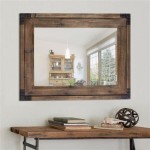How to Hang a Large Mirror Securely
Hanging a large mirror can transform a room, adding light and creating an illusion of space. However, due to their size and weight, large mirrors require careful planning and execution to ensure they are mounted safely and securely. This guide provides a comprehensive walkthrough of the process, from selecting the right hanging method to ensuring the mirror is level and stable.
Assessing the Mirror and Wall
Before beginning the installation, carefully assess both the mirror and the wall where it will be hung. Consider the mirror's weight, dimensions, and any existing hanging hardware. Evaluate the wall's construction material, whether it's drywall, plaster, concrete, or brick. This information is crucial for choosing appropriate hanging hardware and ensuring the wall can support the mirror's weight.
Choosing the Right Hanging Hardware
Selecting the correct hanging hardware is paramount for safety and stability. Several options are available, each suited to different mirror types and wall constructions:
- D-Rings and Wire: A common method for lighter mirrors, D-rings are attached to the back of the mirror and connected with wire. This wire is then hung on hooks or screws in the wall.
- J-Hooks: These hooks are designed for mirrors with pre-installed hanging hardware, such as keyhole slots. They offer a secure and flush mount against the wall.
- French Cleats: Ideal for heavier mirrors, French cleats consist of two interlocking pieces of wood or metal. One piece is attached to the wall, and the other to the back of the mirror. The two pieces interlock, creating a strong and stable connection.
- Mirror Mounting Clips: These clips grip the edges of the mirror and are secured to the wall with screws. They provide a minimalist look and are suitable for frameless mirrors.
- Heavy-Duty Wall Anchors: Regardless of the chosen hanging method, using appropriate wall anchors is essential for heavier mirrors. Toggle bolts, molly bolts, and expansion anchors provide significantly greater holding power than standard screws, especially in drywall or plaster.
Locating and Marking Stud Locations
Hanging heavy objects on wall studs provides the most secure mounting. Use a stud finder to locate the studs in the wall where the mirror will be hung. Mark the stud locations with a pencil or masking tape.
Preparing the Wall
Once the stud locations are marked, prepare the wall for the chosen hanging hardware. If using screws, pre-drilling pilot holes is recommended, especially in harder wall materials. For wall anchors, follow the manufacturer's instructions for installation.
Installing the Hanging Hardware
Carefully install the chosen hanging hardware on the back of the mirror, following the manufacturer's instructions. Ensure the hardware is level and evenly spaced for balanced support. If using D-rings and wire, make sure the wire is taut but not overly tight. For French cleats, ensure the two pieces align correctly.
Positioning and Hanging the Mirror
With the wall and mirror prepared, carefully position the mirror against the wall, aligning the hanging hardware with the installed wall anchors or hooks. For heavier mirrors, having an assistant can be helpful. Gently lower the mirror onto the hardware, ensuring it is securely in place. Check the mirror's stability by applying gentle pressure to various points.
Checking for Level and Making Adjustments
Use a level to ensure the mirror is hanging straight. If adjustments are needed, shims can be placed behind the mirror to achieve perfect alignment. Small adhesive bumpers can also be placed on the bottom corners of the mirror to prevent it from tilting forward.
Final Safety Check
After the mirror is hung and leveled, perform a final safety check. Ensure the hanging hardware is securely attached to both the mirror and the wall. Gently shake the mirror to confirm its stability. Regularly inspect the hanging hardware over time to ensure it remains secure.
Alternative Hanging Methods for Specific Situations
For very large or unusually shaped mirrors, specialized hanging systems or professional installation may be necessary. Adhesive mounting systems are available for certain mirror types and wall materials but are generally not recommended for heavy mirrors. Consulting a professional installer is advised for particularly challenging installations or valuable mirrors.
Protecting the Mirror During and After Installation
Throughout the installation process, take precautions to protect the mirror's surface from scratches or damage. Use soft cloths or blankets to cushion the mirror during handling and installation. After hanging, consider applying protective film to the mirror's surface to prevent future scratches or smudges.

How To Hang A Heavy Mirror C R F T

How To Hang A Frameless Mirror On The Wall With Pictures

How To Hang A Heavy Full Length Leaner Mirror On The Wall House Of Hepworths

How To Hang A Heavy Full Length Leaner Mirror On The Wall House Of Hepworths

How I Installed A Really Big Mirror Merrypad Diy Network

How To Hang A Heavy Full Length Leaner Mirror On The Wall Hanging Over Door

How To Hang A Heavy Full Length Leaner Mirror On The Wall House Of Hepworths

How To Hang A Wall Of Mirrors The Handyman

Mirror Installation Without Clips

How To Hang A Heavy Mirror Daisymaebelle In 2024 Home Diy Decor








